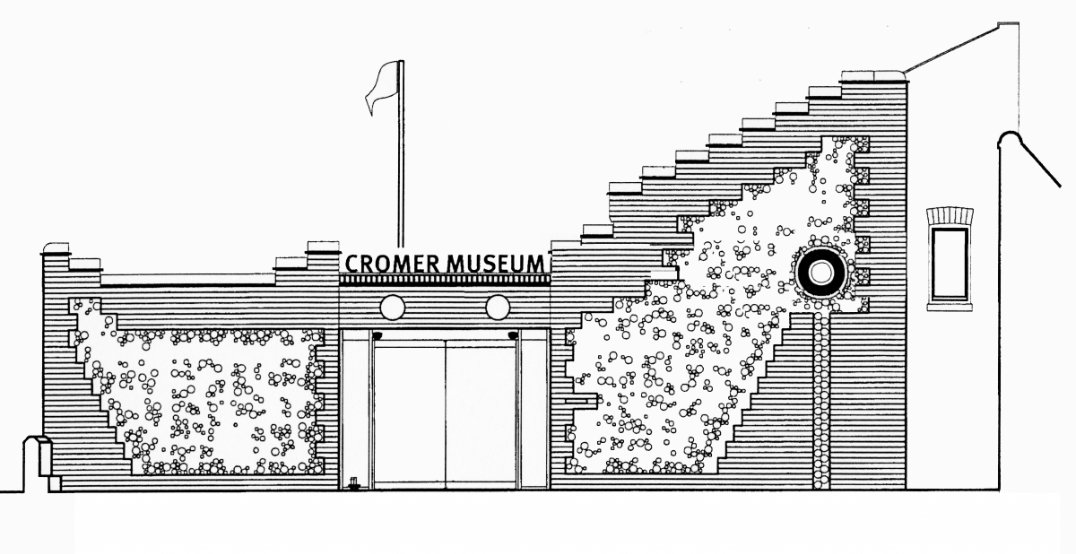Rev John Gunn
John Gunn (1801–1890) was a distinguished clergyman, palaeontologist, and fossil collector whose work in North Norfolk significantly contributed to the understanding of the region's geology and palaeontology. Born in Irstead, Norfolk, Gunn grew up in a rural environment that fostered his lifelong fascination with natural history. His early exposure to the Norfolk landscape, particularly the cliffs and broads, laid the foundation for his scientific pursuits, which he balanced alongside his clerical duties.
Early Life and Education
 John Gunn in a painting by H. H. Roberts, NWHCM: 2005.451Gunn was born on October 9, 1801, in Irstead, Norfolk. His father, the Rev. William Gunn, was Rector of Irstead and Vicar of Barton Turf, and a man of literary and historical interests. Gunn inherited his father's intellectual curiosity, but his passion for natural history emerged early. As a child, he was captivated by the discovery of fossilised elephant bones in the cliffs at Happisburgh, a moment he described as "electric." This fascination with fossils and geology persisted throughout his life.
John Gunn in a painting by H. H. Roberts, NWHCM: 2005.451Gunn was born on October 9, 1801, in Irstead, Norfolk. His father, the Rev. William Gunn, was Rector of Irstead and Vicar of Barton Turf, and a man of literary and historical interests. Gunn inherited his father's intellectual curiosity, but his passion for natural history emerged early. As a child, he was captivated by the discovery of fossilised elephant bones in the cliffs at Happisburgh, a moment he described as "electric." This fascination with fossils and geology persisted throughout his life.
Educated at a school in Wymondham and Norwich Grammar School, Gunn later attended Exeter College, Oxford, where he matriculated in 1819 and earned his B.A. in 1824 and M.A. in 1827. Although geology was not formally part of his studies, Gunn's interest in the subject grew during his time at Oxford, where he was likely influenced by the lectures of William Buckland, the university's Professor of Geology.
Clerical Career and Scientific Pursuits
.jpg?_t=1750702319) The church of St Michael and All Angels at Barton Turf, where Gunn was vicar.After briefly studying law in London, Gunn decided to follow in his father's footsteps and enter the ministry. He was ordained in 1829 and, in the footsteps of his father, became Rector of Irstead and Vicar of Barton Turf. Despite his clerical responsibilities, Gunn devoted much of his leisure time to scientific pursuits, particularly geology and palaeontology. His proximity to the Norfolk coast allowed him to explore the cliffs and foreshore, which were rich in fossil deposits.
The church of St Michael and All Angels at Barton Turf, where Gunn was vicar.After briefly studying law in London, Gunn decided to follow in his father's footsteps and enter the ministry. He was ordained in 1829 and, in the footsteps of his father, became Rector of Irstead and Vicar of Barton Turf. Despite his clerical responsibilities, Gunn devoted much of his leisure time to scientific pursuits, particularly geology and palaeontology. His proximity to the Norfolk coast allowed him to explore the cliffs and foreshore, which were rich in fossil deposits.
Gunn's scientific work focused on the Cromer Forest-bed, the series of pre-glacial deposits exposed along the cliffs between Weybourne and Happisburgh. This formation, which includes estuarine soils, laminated clays, and gravel beds, is notable for its fossilised remains of plants and animals from the Pleistocene epoch. Gunn's meticulous observations and collections from this area earned him recognition as one of Norfolk's leading geologists.
Contributions to Fossil Collection and Palaeontology
Gunn's fossil collection was extensive and included numerous specimens of large mammals, such as elephants, deer, and mastodons, as well as smaller vertebrates and plant remains. He was particularly interested in the Mammalian fossils of the Forest-bed and the Norwich Crag, a nearby geological formation. His collection became a valuable resource for other scientists, including Dr. Hugh Falconer and Dr. Leith Adams, who studied the elephant remains Gunn had gathered. He liaised with the young Alfred Savin on a number of occasions.
One of Gunn's notable contributions was his identification of the Mastodon arvernensis in the Norwich Crag, a discovery that highlighted the presence of this extinct species in the region. He also recognised the significance of the Forest-bed as an estuarine deposit, suggesting that it represented the remains of a prehistoric river system that flowed westward into the German Ocean.
Gunn's fieldwork often involved excursions to the Norfolk coast, where he collected fossils after storms or erosion events exposed new layers of sediment. He maintained close relationships with local fishermen and labourers, who frequently brought him specimens. His dedication to fossil collection was such that he once remarked that his Mammalian remains threatened to "engross the chief part of my house at Irstead."
Scientific Collaborations and Legacy
 Part of the drawing from "Memorials of John Gunn" of the mammoth jaw which he tracked down to being found by workmen engaged in constructing the gatway (Gangway) at CromerGunn's work brought him into contact with many prominent geologists of his time, including Sir Charles Lyell, Prof. Prestwich, and Sir Richard Owen. He hosted visiting scientists at Irstead Rectory and guided them on excursions to the Norfolk cliffs. His observations and collections were frequently cited in their published works, and his expertise in identifying and interpreting fossils was widely respected.
Part of the drawing from "Memorials of John Gunn" of the mammoth jaw which he tracked down to being found by workmen engaged in constructing the gatway (Gangway) at CromerGunn's work brought him into contact with many prominent geologists of his time, including Sir Charles Lyell, Prof. Prestwich, and Sir Richard Owen. He hosted visiting scientists at Irstead Rectory and guided them on excursions to the Norfolk cliffs. His observations and collections were frequently cited in their published works, and his expertise in identifying and interpreting fossils was widely respected.
In 1868, Gunn donated his extensive fossil collection to the Norwich Museum, where it became a cornerstone of the institution's geological exhibits. The collection was housed in a room named the "Gunn Room," a testament to his contributions to the museum and the scientific community. Gunn's generosity extended to allowing researchers to study and even cut sections of his specimens for scientific purposes.
Geological Theories and Publications
Gunn was an active member of the Norfolk and Norwich Geological Society, serving as its president for many years. He delivered numerous lectures and papers on the geology of Norfolk, often focusing on the Cromer Forest-bed and the Norwich Crag. His publications include a "Sketch of the Geology of Norfolk," first published in 1864 and revised in 1883. This work provided a comprehensive overview of the region's geological formations and their fossil content.
Gunn's theories on the Forest-bed were influential but not without controversy. He argued that the stumps of trees found in the Estuarine portion of the Forest Bed represented an ancient forest that grew in situ. This view was debated by other geologists, who suggested that the stumps were part of a reconstructed deposit. Despite these differences, Gunn's observations contributed significantly to the understanding of the Forest-bed's stratigraphy and palaeontology.
Personal Life and Character
Gunn was known for his enthusiasm, generosity, and single-minded dedication to science. He balanced his scientific pursuits with his clerical duties, earning the respect and affection of his parishioners. He was a kind-hearted man who held evening classes for young men and supported the poor in his community. His forgiving nature and personal integrity were widely admired.
In 1869, Gunn resigned his clerical positions following the death of his first wife, Harriette Turner, and travelled extensively in Europe and the Middle East. He later settled in Norwich, where he continued his scientific work and became involved in local societies, including the Norwich Science Gossip Club.
Final Years and Legacy
John Gunn died on May 28, 1890, at the age of 88. He was buried at the Rosary Cemetery in Norwich. His contributions to geology and palaeontology, particularly his work on the Cromer Forest-bed, remain a lasting legacy. Gunn's dedication to fossil collection and his ability to inspire others through his enthusiasm and generosity made him a central figure in the scientific community of Norfolk.
Today, Gunn is remembered as a pioneer in the study of Norfolk's geology and a passionate advocate for the preservation and understanding of the region's natural history. His work laid the foundation for future research and continues to be a source of inspiration for geologists and palaeontologists.




